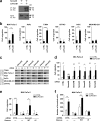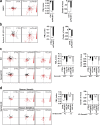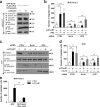A reverse signaling pathway downstream of Sema4A controls cell migration via Scrib
- PMID: 28007914
- PMCID: PMC5223600
- DOI: 10.1083/jcb.201602002
A reverse signaling pathway downstream of Sema4A controls cell migration via Scrib
Abstract
Semaphorins comprise a large family of ligands that regulate key cellular functions through their receptors, plexins. In this study, we show that the transmembrane semaphorin 4A (Sema4A) can also function as a receptor, rather than a ligand, and transduce signals triggered by the binding of Plexin-B1 through reverse signaling. Functionally, reverse Sema4A signaling regulates the migration of various cancer cells as well as dendritic cells. By combining mass spectrometry analysis with small interfering RNA screening, we identify the polarity protein Scrib as a downstream effector of Sema4A. We further show that binding of Plexin-B1 to Sema4A promotes the interaction of Sema4A with Scrib, thereby removing Scrib from its complex with the Rac/Cdc42 exchange factor βPIX and decreasing the activity of the small guanosine triphosphatase Rac1 and Cdc42. Our data unravel a role for Plexin-B1 as a ligand and Sema4A as a receptor and characterize a reverse signaling pathway downstream of Sema4A, which controls cell migration.
© 2017 Sun et al.
Figures







Similar articles
-
Scrib regulates PAK activity during the cell migration process.Hum Mol Genet. 2008 Nov 15;17(22):3552-65. doi: 10.1093/hmg/ddn248. Epub 2008 Aug 20. Hum Mol Genet. 2008. PMID: 18716323
-
Sema4A induces cell morphological changes through B-type plexin-mediated signaling.Int J Mol Med. 2010 Feb;25(2):225-30. Int J Mol Med. 2010. PMID: 20043131
-
The polarity protein Scrib limits atherosclerosis development in mice.Cardiovasc Res. 2019 Dec 1;115(14):1963-1974. doi: 10.1093/cvr/cvz093. Cardiovasc Res. 2019. PMID: 30949676
-
The Plexin-B family and its role in cancer progression.Histol Histopathol. 2014 Feb;29(2):151-65. doi: 10.14670/HH-29.151. Epub 2013 Sep 17. Histol Histopathol. 2014. PMID: 24043639 Review.
-
Neuroimmune Semaphorin 4A in Cancer Angiogenesis and Inflammation: A Promoter or a Suppressor?Int J Mol Sci. 2018 Dec 30;20(1):124. doi: 10.3390/ijms20010124. Int J Mol Sci. 2018. PMID: 30598022 Free PMC article. Review.
Cited by
-
Tumor-derived semaphorin 4A improves PD-1-blocking antibody efficacy by enhancing CD8+ T cell cytotoxicity and proliferation.Sci Adv. 2023 May 19;9(20):eade0718. doi: 10.1126/sciadv.ade0718. Epub 2023 May 19. Sci Adv. 2023. PMID: 37205755 Free PMC article.
-
Plexin-B1 and Plexin-B2 play non-redundant roles in GABAergic synapse formation.Mol Cell Neurosci. 2024 Mar;128:103920. doi: 10.1016/j.mcn.2024.103920. Epub 2024 Feb 6. Mol Cell Neurosci. 2024. PMID: 38331011 Free PMC article.
-
Early loss of Scribble affects cortical development, interhemispheric connectivity and psychomotor activity.Sci Rep. 2021 Apr 27;11(1):9106. doi: 10.1038/s41598-021-88147-1. Sci Rep. 2021. PMID: 33907211 Free PMC article.
-
Semaphorin Signaling in Cancer-Associated Inflammation.Int J Mol Sci. 2019 Jan 17;20(2):377. doi: 10.3390/ijms20020377. Int J Mol Sci. 2019. PMID: 30658382 Free PMC article. Review.
-
Caenorhabditis elegans LET-413 Scribble is essential in the epidermis for growth, viability, and directional outgrowth of epithelial seam cells.PLoS Genet. 2021 Oct 21;17(10):e1009856. doi: 10.1371/journal.pgen.1009856. eCollection 2021 Oct. PLoS Genet. 2021. PMID: 34673778 Free PMC article.
References
-
- Anastasilakis A.D., Polyzos S.A., Makras P., Gkiomisi A., Sakellariou G., Savvidis M., Papatheodorou A., Kokkoris P., and Terpos E.. 2015. Circulating semaphorin-4D and plexin-B1 levels in postmenopausal women with low bone mass: the 3-month effect of zoledronic acid, denosumab or teriparatide treatment. Expert Opin. Ther. Targets. 19:299–306. 10.1517/14728222.2014.983078 - DOI - PubMed
-
- Armendáriz B.G., Bribian A., Pérez-Martínez E., Martínez A., de Castro F., Soriano E., and Burgaya F.. 2012. Expression of Semaphorin 4F in neurons and brain oligodendrocytes and the regulation of oligodendrocyte precursor migration in the optic nerve. Mol. Cell. Neurosci. 49:54–67. 10.1016/j.mcn.2011.09.003 - DOI - PubMed
Publication types
MeSH terms
Substances
LinkOut - more resources
Full Text Sources
Other Literature Sources
Molecular Biology Databases
Research Materials
Miscellaneous

